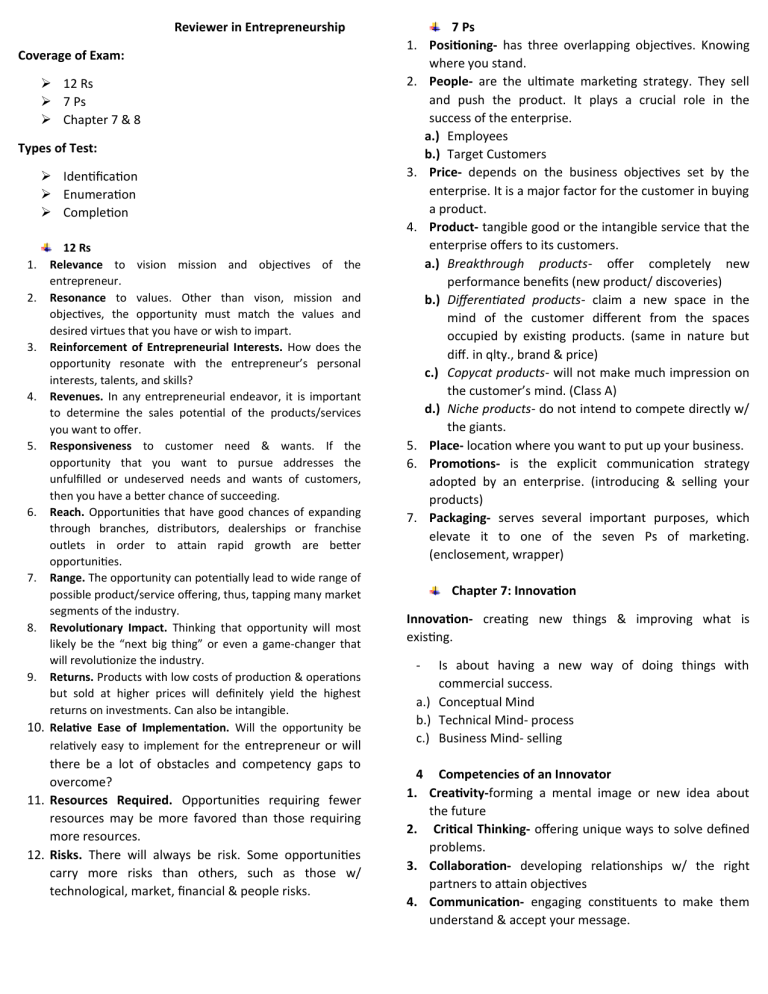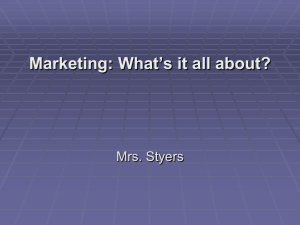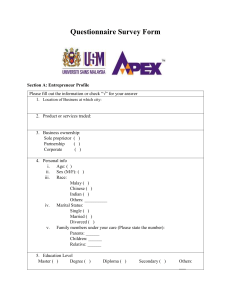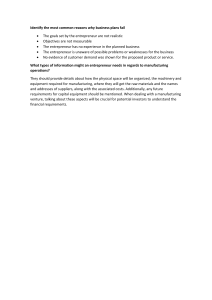
Reviewer in Entrepreneurship Coverage of Exam: 12 Rs 7 Ps Chapter 7 & 8 Types of Test: Identification Enumeration Completion 12 Rs Relevance to vision mission and objectives of the entrepreneur. 2. Resonance to values. Other than vison, mission and objectives, the opportunity must match the values and desired virtues that you have or wish to impart. 3. Reinforcement of Entrepreneurial Interests. How does the opportunity resonate with the entrepreneur’s personal interests, talents, and skills? 4. Revenues. In any entrepreneurial endeavor, it is important to determine the sales potential of the products/services you want to offer. 5. Responsiveness to customer need & wants. If the opportunity that you want to pursue addresses the unfulfilled or undeserved needs and wants of customers, then you have a better chance of succeeding. 6. Reach. Opportunities that have good chances of expanding through branches, distributors, dealerships or franchise outlets in order to attain rapid growth are better opportunities. 7. Range. The opportunity can potentially lead to wide range of possible product/service offering, thus, tapping many market segments of the industry. 8. Revolutionary Impact. Thinking that opportunity will most likely be the “next big thing” or even a game-changer that will revolutionize the industry. 9. Returns. Products with low costs of production & operations but sold at higher prices will definitely yield the highest returns on investments. Can also be intangible. 10. Relative Ease of Implementation. Will the opportunity be relatively easy to implement for the entrepreneur or will 1. there be a lot of obstacles and competency gaps to overcome? 11. Resources Required. Opportunities requiring fewer resources may be more favored than those requiring more resources. 12. Risks. There will always be risk. Some opportunities carry more risks than others, such as those w/ technological, market, financial & people risks. 7 Ps 1. Positioning- has three overlapping objectives. Knowing where you stand. 2. People- are the ultimate marketing strategy. They sell and push the product. It plays a crucial role in the success of the enterprise. a.) Employees b.) Target Customers 3. Price- depends on the business objectives set by the enterprise. It is a major factor for the customer in buying a product. 4. Product- tangible good or the intangible service that the enterprise offers to its customers. a.) Breakthrough products- offer completely new performance benefits (new product/ discoveries) b.) Differentiated products- claim a new space in the mind of the customer different from the spaces occupied by existing products. (same in nature but diff. in qlty., brand & price) c.) Copycat products- will not make much impression on the customer’s mind. (Class A) d.) Niche products- do not intend to compete directly w/ the giants. 5. Place- location where you want to put up your business. 6. Promotions- is the explicit communication strategy adopted by an enterprise. (introducing & selling your products) 7. Packaging- serves several important purposes, which elevate it to one of the seven Ps of marketing. (enclosement, wrapper) Chapter 7: Innovation Innovation- creating new things & improving what is existing. - Is about having a new way of doing things with commercial success. a.) Conceptual Mind b.) Technical Mind- process c.) Business Mind- selling 4 Competencies of an Innovator 1. Creativity-forming a mental image or new idea about the future 2. Critical Thinking- offering unique ways to solve defined problems. 3. Collaboration- developing relationships w/ the right partners to attain objectives 4. Communication- engaging constituents to make them understand & accept your message. How to Improve Creativity and be an Innovator A. B. C. D. (12 practices within 4 pillars) Knowledge Update-new ideas gained from experience and/ or education. 1. Read- to study diverse topics 2. Watch- to observe other categories and industries 3. Online Browsing- to do social listening Process- a sequence of steps to attain new ideas 4. Conversations- to have interactions w/ experts & those with divergent views. 5. Think like a child- to be curious and keep asking questions 6. Probe- to do data gathering and look for people’s motivations and deeper meanings. 7. Rest & Recreation- to have a well- rested mind to welcome ideas with clarity. Reflections- serious thinking about a particular problem/idea to increase & retain creative proficiency 8. Openness- to listen to the opinions & ideas of others 9. Mind mapping- to have a process of organizing information 10. Me time- to practice tasks and habits regularly Experiences- actual encounters with subjects 11. Inspiration- to be mentally stimulated w/ diff. sources like visuals, plays, etc. 12. Travel- to take trips, especially in trend hubs, to observe new ideas in other places 8 Tips to Create an Innovation Mindset 1. Hiring- recruit & select some people who are non -conformists with uncommon sense instead of acquiring the usual people 2. Training- Create innovation competency by providing tools, frameworks and methods that are duplicable, ending with an annual innovation tournament. 3. Idea Channel & Champion- provide employees a “safe place” to have the option to submit to a highlevel innovation executive, if their immediate superior would turn down a major proposal which they believe has high potential. 4. Behavioral Requirement- establish innovation as a pre requisite for promotion and merit raise on top of revenue and profit growth. 5. Focus- mull over business innovation, instead of just product and process innovation. 6. Bottom line- look into the long-term effect of market penetration, and not just short-term. 7. Reward and recognition- create a climate where innovation is rewarded or recognized. 8. Time- allow specific time for people to work on focused innovation projects during regular work hours. 5- Point Marketing Innovation Tool- It provides five ways to “reinvent” each element of the marketing mix. SCENIC MODEL/ framework- another way to foster innovation thinking, to help entrepreneurs and innovators reflect on innovation possibilities based on pain points they are focused on solving. Chapter 8: Execution: Machinery, Methods & Management Skills Machinery- is an organization structure that can deliver the value planned. Methods- systems and processes that allow the entrepreneur information and control Value Chain- is the strategic linkage or a series of valueadding individual activities required to create, produce and deliver products & services to the customers. Value Network/ Ecosystem- is an expanded value chain that shows the involvement of other stakeholders in each value chain stage to co- create value. Value network is also called an ecosystem. Resources- are about hard assets and soft assets that are difficult to imitate, & provide an advantage to firms. - HARD ASSETS- are physical, financial and intangible assets - SOFT ASSETS- are human assets like relationships, skills and knowledge. Processes- is the way to transform inputs into outputs. Complementors- these are other people that helps the enterprise in delivering the value proposition.


